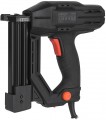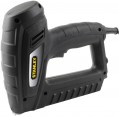Compatible staples
Staple models that the tool is compatible with.
Usually, quite specific options are indicated in this paragraph, so finding compatible consumables is not difficult. The specific dimensions of the fasteners should be specified according to the manufacturer's data — different brands use different markings.
Power consumption
The total power consumed by a mains-powered electric tool (see "Power Source"). It is considered the main criterion for assessing the overall capabilities of a particular model: more power leads to better performance. In addition, data on power consumption also allows you to estimate the load on the power grid or other power source; in some cases this is unnecessary.
Performance
The maximum output of a nailer/stapler is the maximum number of strokes it can produce in a minute. Note that in this case, the theoretical maximum is usually indicated — the highest speed of operation achievable under perfect conditions, in fact — the rate of operation of automation, which in many models exceeds 120 beats / min. In fact, this speed is difficult to achieve, because. the performance of the stapler is noticeably limited by the skills of the operator and the features of the functionality: for example, a tool with contact actuation (see below) must be pressed every time, which reduces the speed of work. However,
high performance clearly indicates good reliability and suitability for large volumes of work.
Max. staple width
The largest width of staples (see Fastener Type) that the stapler can work with.
The width of the bracket is, roughly speaking, the distance between its legs. Different situations and types of work require different sizes of staples, and sometimes the width must be quite large. However, a staple that is too large simply will not fit into the store, not to mention the fact that the stapler can “shoot” it normally. Therefore, this limit cannot be exceeded, and if you plan to work with brackets, you should pay special attention to the maximum width when choosing.
Min. staple length
The smallest length of staples (see Fastener Type) that the stapler can work with.
The length in this case means the length of the leg — in other words, the depth to which the staple clogged "to the stop" penetrates into the material. Small staples do not require much power to drive, but the tool may not be designed for fasteners that are too short due to other parameters — for example, the design of the magazine. Therefore, for many models, this limitation is quite relevant, and in powerful professional models, the minimum length can be quite large — more than 20 mm.
Max. staple length
The largest length of staples (see Fastener Type) that the stapler can work with.
The length in this case means the length of the leg — in other words, the depth to which the staple clogged "to the stop" penetrates into the material. This means that working with staples of great length requires not only the appropriate design of the magazine and the feed mechanism — the stapler must also be quite powerful in order to provide the effort necessary for effective clogging. And this, in turn, affects the dimensions, weight and price of the tool. In fact, this means that it does not always make sense to specifically look for a model that can work with long staples — you need to evaluate the specifics of the intended work: often the best choice is a relatively “short”, but at the same time inexpensive and compact tool.
In general, a limit of 10 – 15 mm is typical for entry-level staplers, and in professional models this parameter can exceed 50 mm.
Min. nail length
The shortest length of nails (see Fastener Type) that the stapler can handle.
The shorter the fastener, with the same thickness, the less effort is required to drive it, but a nail that is too short simply cannot stand under impact normally. Therefore, for many instruments, this restriction is directly indicated. It is worth paying attention to it first of all if you plan to work with small short nails.
Staples included
The number of staples supplied with the stapler.
Construction staplers can be supplied with a stock of fasteners (staples, nails, pins) — so that you can immediately start working without buying more consumables. And knowing the number of such parts, you can not only determine how much the initial stock will last, but also evaluate how profitable the purchase of this model will be compared to the model without consumables in the kit. For example, a relatively expensive model that comes with 1,000 staples can end up being a better value than a cheaper tool that doesn't come with any hardware.
Nails included
The number of nails supplied with the stapler.
Construction staplers can be supplied with a stock of fasteners (staples, nails, pins) — so that you can immediately start working without buying more consumables. And knowing the number of such parts, you can not only determine how much the initial stock will last, but also evaluate how profitable the purchase of this model will be compared to the model without consumables in the kit. For example, a relatively expensive model that comes with 200 nails, as a result may be more profitable than a cheaper tool that does not come with any fasteners.

